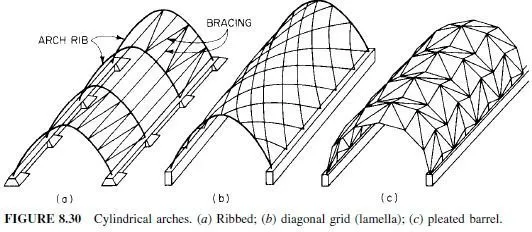A great variety of forms have been used for trussed or solid-ribbed arch brides. The following are some of the principal forms used.
Lindenthals Hell Gate Bridge over the East River in New York has trusses deep at the ends and shallow at the crown. The bottom chord is a regular arch form. The top chord follows a reversed curve transitioning from the deep truss at the end to the shallow truss at the center. Accordingly, it is customary to refer to arch trusses of this form as Hell-Gatetype trusses. In another form commonly used, top and bottom chords are parallel. For a twohinged arch, a crescent-shaped truss is another logical form.
For solid-ribbed arches, single-web or box girders may be used. Solid-ribbed arches usually are built with girders of constant depth. Variable-depth girders, tapering from deep sections at the springing to shallower sections at the crown, however, have been used occasionally for longer spans. As with trussed construction, a crescent-shaped girder is another possible form for a two-hinged arch.
Tied arches permit many variations in form to meet specific site conditions. In a true arch (without ties), the truss or solid rib must carry both thrust and moment under variable loading conditions. These stresses determine the most effective depth of truss or girder. In a tied arch, the thrust is carried by the arch truss or solid rib, but the moment for variable loading conditions is divided between arch and tie, somewhat in proportion to the respective stiffnesses of these two members. For this reason, for example, if a deep girder is used for the arch and a very shallow member for the tie, most of the moment for variable loading is carried by the arch rib. The tie acts primarily as a tension member. But if a relatively deep member is used for the tie, it carries a high proportion of the moment, and a relatively shallow member may be used for the arch rib. In some cases, a truss has been used for the arch tie in combination with a shallow, solid rib for the arch. This combination may be particularly applicable for double-deck construction.
Rigid-framed bridges, sometimes used for grade-separation structures, are basically another form of two-hinged or fixed arch. The generally accepted arch form is a continuous, smooth-curve member or a segmental arch (straight between panel points) with breaks located on a smooth-curve axis. For a rigid frame, however, the arch axis becomes rectangular in form. Nevertheless, the same principles of stress analysis may be used as for the smoothcurve arch form.
The many different types and forms of arch construction make available to bridge engineers numerous combinations to meet variable site conditions.



